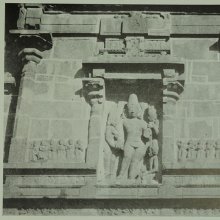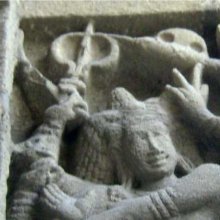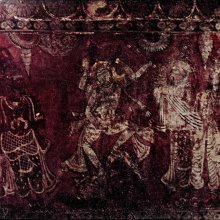Natesha, Naṭeśa: 2 definitions
Introduction:
Natesha means something in Hinduism, Sanskrit. If you want to know the exact meaning, history, etymology or English translation of this term then check out the descriptions on this page. Add your comment or reference to a book if you want to contribute to this summary article.
The Sanskrit term Naṭeśa can be transliterated into English as Natesa or Natesha, using the IAST transliteration scheme (?).
Images (photo gallery)
In Hinduism
Shilpashastra (iconography)
Source: Archaeological Survey of India: Śaiva monuments at Paṭṭadakal (śilpa)Naṭeśa (नटेश) is found as a sculpture at the temple of Lokeśvara, maṇḍapa wall, north side, facing north.—A four-handed dancing Śiva is placed in a niche on the top of which is a four-handed, seated image of Śiva with two demigods decorating or eulogizing him. Once upon a time the dancing Śiva must have been an exquisitely carved sculpture, but now it has suffered much in the hands of vandals and time. The image, from its remnants looks like that of dancing Śiva. According to T. A. G. Rao “this kind of images are commonly known as bhujaṅgatrāsa”. But, here Śiva holds in his right and left rear hands snake and trident respectively.

Shilpashastra (शिल्पशास्त्र, śilpaśāstra) represents the ancient Indian science (shastra) of creative arts (shilpa) such as sculpture, iconography and painting. Closely related to Vastushastra (architecture), they often share the same literature.
Languages of India and abroad
Sanskrit dictionary
Source: Cologne Digital Sanskrit Dictionaries: Aufrecht Catalogus CatalogorumNaṭeśa (नटेश) as mentioned in Aufrecht’s Catalogus Catalogorum:—author of Naṭeśapaddhati. Mentioned by Vedajñāna in Ātmārthapūjāpaddhati. Hz. 2 p. 106.
Sanskrit, also spelled संस्कृतम् (saṃskṛtam), is an ancient language of India commonly seen as the grandmother of the Indo-European language family (even English!). Closely allied with Prakrit and Pali, Sanskrit is more exhaustive in both grammar and terms and has the most extensive collection of literature in the world, greatly surpassing its sister-languages Greek and Latin.
See also (Relevant definitions)
Starts with: Nateshavijaya.
Ends with: Unnatesha.
Full-text: Nateshavijaya, Bezvada.
Relevant text
Search found 10 books and stories containing Natesha, Naṭeśa, Natesa; (plurals include: Nateshas, Naṭeśas, Natesas). You can also click to the full overview containing English textual excerpts. Below are direct links for the most relevant articles:
Abhinaya-darpana (English) (by Ananda Coomaraswamy)
Temples of Munnur (Historical Study) (by R. Muthuraman)
Adi Puram (July-August) < [Chapter 6]
Kathasaritsagara (the Ocean of Story) (by Somadeva)
Vetāla 23: The Hermit who first Wept and then Danced < [Appendix 6.1 - The Twenty-five Tales of a Vetāla]
Vetāla 14: The Merchant’s Daughter who fell in love with a Thief < [Appendix 6.1 - The Twenty-five Tales of a Vetāla]
Foreword to volume 6 < [Forewords]
Pallava period (Social and Cultural History) (by S. Krishnamurthy)
Mekhala (girdle) < [Chapter 4 - Material Culture of the People]
Ornamental Diagonal Band across the Body < [Chapter 4 - Material Culture of the People]
Weapons and Warfare < [Chapter 4 - Material Culture of the People]
Village Folk-tales of Ceylon (Sri Lanka), vol. 1-3 (by Henry Parker)
Story 6 - The Millet Trader < [Part I - Stories told by the Cultivating Caste and Vaeddas]
Story 14 - The Four Deaf Persons < [Part I - Stories told by the Cultivating Caste and Vaeddas]
Story 9 - Tamarind Tikka < [Part I - Stories told by the Cultivating Caste and Vaeddas]
Sanskrit sources of Kerala history (by Suma Parappattoli)
The Padmaneri Grant of Venkatapati I < [Chapter 1 - Historical details from Sanskrit Inscriptions]


